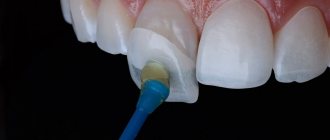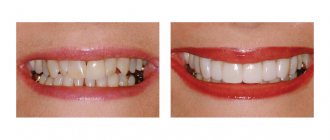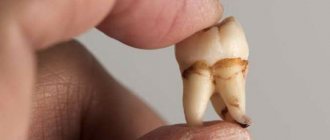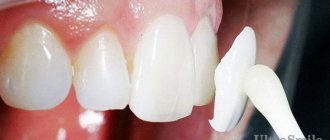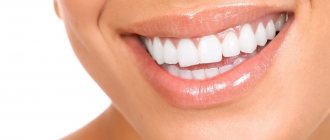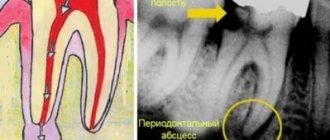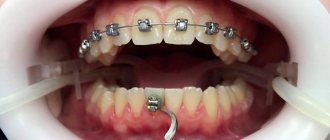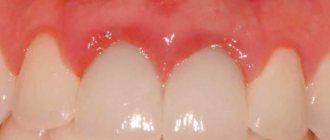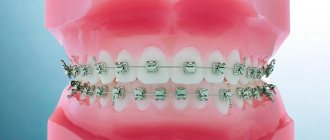In general, the condition of the front teeth greatly affects the aesthetics of your smile. Darkening of the front tooth makes patients want to solve the problem of darkening as quickly as possible - this is a good motivation to visit an endodontist. Especially if you are going to correct your bite using aligners or braces. If a patient’s tooth has darkened, this is a unique and timely motivation to take care of the health of their teeth.
Agree, when even one front tooth has darkened, this is a serious aesthetic problem that affects the eyes of others!
We asked our colleague, chief physician of the German Implantology Center Magomed Dakhkilgov, to talk about the problem of darkened teeth and ways to solve it.
For reference:
Magomed Dakhgilkov - maxillofacial surgeon, implantologist, orthopedist.
The total work experience is more than 20 years, more than 5 thousand dental surgeries have been performed. The doctor who created the German implantology clinics, which today are the best in ratings both in Moscow and in Russia. In his clinics, doctors work exclusively using a microscope and use an analytical approach to dental treatment with maximum preservation of nerve endings. The doctor’s motto is “ The tooth must live
.”
Causes of blue teeth
Teeth can turn blue for certain reasons, some of which indicate some kind of disease, others are normal. There are the following causes of blue teeth:
Coloring food
For example, if you like to eat fresh berries, such as blueberries or blackberries, you should expect the enamel to turn blue. Grape juice can also cause enamel to turn blue. In this case, not one, but all teeth turn blue;
Recent dental filling
Sometimes fresh fillings may have a brighter shade; In addition, after removal of the pulp, a non-viable tooth may acquire a bluish tint over the years.
Taking medications
The teeth of children and adults can turn blue when taking any medications. Some antibacterial agents cause discoloration of teeth, for example, medications with tetracyclines (especially minocycline);
Dental diseases and problems
Sometimes a blue tooth indicates that its roots are dying. Most often, before this, a person suffers from serious diseases, such as periodontal disease. The root slowly deteriorates, leading to tooth loss;
Disturbed functioning of the body
Doctors say that a common cause of blue teeth is problems in the body, such as problems with the digestive system;
Long-term consumption of iron-rich water
The iron content in water depends on the environment and terrain;
Hyperthyroidism
With hyperthyroidism, the enamel may also have a bluish or bluish tint.
Once you have discovered blue discoloration of your teeth enamel, you can try brushing your teeth. If the plaque has lightened, then the problem arose due to nutrition. It's worth changing it a little so that this doesn't happen to you again. For example, eat as much protein and dairy products as possible.
If the color of the enamel remains, you need to consult a doctor, he will talk with you, conduct an examination, and also help you find out the cause of blue teeth and answer what treatment you need.
To treat or not?
What to do if a blue tooth appears? Is there any way to treat the symptom? It all depends on what exactly caused this symptom. To start, try simply using a toothbrush and toothpaste. Thoroughly clean the enamel on all sides and rinse your teeth. After this, evaluate their condition. If the enamel has become lighter, then most likely it is due to nutrition. Review your diet. Eat more dairy products and protein-containing meals.
Treatment of blue teeth
Most often, doctors prescribe professional teeth cleaning or polishing. If the enamel of the teeth is stained due to the influence of food, then after cleaning and polishing with the help of dental compounds and devices, the problem will be solved. If after the procedures the blueness of the teeth has not gone away, then treatment can be carried out using special methods:
- X-ray. Necessary for the doctor to correctly diagnose;
- Removal of old fillings and tooth tissues already damaged by caries;
- Treatment of tooth root canals. Carried out as necessary.
The restoration option is selected based on the volume of fillings to be installed:
- Artistic direct restoration. The doctor places a light-cured composite filling (done using a rubber dam - a latex plate to isolate individual teeth from the rest of the oral cavity);
- Indirect restoration. The doctor installs a crown or veneers made of ceramics.
Contact your dentist
If after all hygiene procedures the blue color of the tooth has not disappeared, then you should visit a doctor as soon as possible. Contact your dentist. The doctor will examine the stained tooth and take an x-ray if necessary. After this we can already talk about treatment. If the root is damaged, the pathological shoot will have to be removed. If everything is not so serious, then the dentist will offer you a suitable correction plan.
If a specialist (dentist or dentist) does not find a pathology in his area, you need to contact a therapist. If you have recently taken certain medications, be sure to tell your doctor. The doctor may ask you to undergo basic tests. They will help you understand the situation and prescribe the appropriate correction. In most cases, the pathological symptom disappears after a few days of treatment.
What helps with a blue tooth?
People don't experience blue teeth very often. Typically, teeth from which the pulp has been removed turn blue. In this case, regular whitening does not help, and usually they write on forums that they do intra-canal whitening - the fillings are opened and a special whitening gel is placed in the teeth.
The tooth may also turn blue after injury, in which case treatment, for example, pulp removal, may be required. True, girls encounter such injuries very rarely, since a very strong blow is required - mostly men suffer from this.
Associated symptoms
Gums can turn blue not only in the youngest patients, but also in adults. As a rule, this pathology is accompanied by many other symptoms. Most often, a person experiences noticeable pain, especially with accidental contact with tissue or with solid food, and the gums may swell and bleed.
If the cause of darkening or the appearance of age spots lies in the inflammatory process, the following symptoms can be diagnosed: severe fever and chills, itching and burning, the appearance of blood or purulent discharge, and others. In this case, immediate treatment is required in a dental clinic; traditional methods will not be effective.
If the cause of darkening of the gum or tooth is the incorrect installation of a prosthesis or crown, the patient may complain of pain even at rest, as well as slight tingling and numbness of the tissue (a sensation similar to what happens after the end of anesthesia).
previous post
How is a general examination at the dentist performed?
next entry
Possible consequences after a bruise
It is no secret that any injury received can subsequently cause complications. A tooth bruise is no exception. Moreover, the consequences can appear even when appropriate treatment has been performed. This occurs if the pulp zone has been severely damaged.
The tissue will gradually begin to die and necrosis will appear. With necrosis, inflammation occurs, which must be addressed immediately. The earlier it is identified, the more successful the forecasts will be.
But the most common occurrence is staining. Parents notice that the child’s tooth has darkened after being hit. Darkening occurs quite quickly. This may be due to periodontal trauma, or may be a consequence of a lack of nutrients. They cannot supply what is needed because the dental tissues and fibers are damaged.
There are also more serious violations that occur over time. These include the formation of cysts in damaged areas.
In any of the above cases, adequate treatment often brings positive results.
Baby teeth turn black
Why do baby teeth turn black?
A child’s teeth turn black: how to treat?
Baby teeth are especially susceptible to caries because they have very thin and porous enamel. The main task of parents is to make every effort to maintain the health of their child’s teeth. That is why it is recommended to undergo regular preventive examinations so that the baby learns to care for his teeth from a young age.
Pain is a good signal
The connection between internal organs and teeth and the oral cavity is evidenced by medical statistics on patient treatment accumulated over many years. For example, bad teeth can be a source of headaches. Damage to molars - there is pain in the parieto-occipital region. A source of infection in the maxillary incisors can lead to pain in the frontotemporal region, and from diseased canines the pain can be concentrated in the temporal region. If you have problems with the teeth of the lower jaw, a migraine may develop, and it can only be alleviated by visiting a dentist.
Painful sensations in the upper and lower incisors are a reason to get checked for cystitis, otitis media, or treat chronic pyelonephritis. Pain in the first incisor is a possible syndrome of prostate adenoma, frontal sinusitis, tonsillitis, prostatitis, osteochondrosis. Aching pain in the fangs is possible with hepatitis or cholecystitis.
Chronic pneumonia can be diagnosed by pain in the 4th and 5th molars. The same focus of pain indicates colitis, advanced dysbacteriosis, an allergic reaction (rhinosinusitis, bronchial asthma, respiratory allergosis).
The best specialists from France
François Najjar: French Dental Clinic.
Chief physician, founder of FDC
Since 2004, the doors of the first exclusive French Dental Clinic in Russia have been opened for everyone who wants to have an appointment with famous specialists from Paris, Nice, Cannes, Sophia Antipolis, Lyon, Lille.
Specialists from all areas of dentistry were invited from different parts of France in order to undergo the most stringent selection. The choice fell on professionals with extensive experience of successful work and excellent recommendations.
— French Dental Clinic team
Frank Ajege
Periodontist-implantologist
Experience in surgical dentistry since 1987. Has a private clinic in Nice (France).
Michel Cassagne
Orthodontist
with over 30 years of experience in dentistry. Has a clinic in Paris, specializing in aesthetic orthodontics.
Didier Saada
Dentist
Experience in dentistry since 1988. Graduated from the Faculty of Surgical Dentistry at the Medical University in Marseille.
Questions about prosthetics
Elena
2018-11-17 15:17:00
Hello! I have had temporary plastic crowns for a year and a half now, 8 teeth on the upper jaw and 5 below. The teeth are all cured, some have inlays. These crowns have already been removed and filed several times, the top one is already broken, they glued it together. The orthopedist is in no hurry to do his job, makes an appointment once every month and a half. About five months ago, I began to experience constant itching and a feeling of fullness in the upper jaw, in the place where the crowns are located. Two months ago, it became painful to press on the gum above one tooth, there was no redness as such, and until recently I had a rash on my wrists and elbows, it went away after taking enterosorbents. I have a general malaise and my lips are constantly dry, maybe it has nothing to do with the problem of my teeth. The doctor himself says that wearing plastic is very harmful and at the same time it’s dragging. the itching was bothering me. I have a question for you, is this an inflammatory process or what could it be? I read that plastic releases a monomer that has a toxic effect. What can be done in my case. Thank you if you don’t ignore my question
Shinberg Oleg Emilievich
chief consultant, orthopedic dentist
Dear Elena, it is indeed very harmful to use temporary plastic crowns made by polymerization for a long time, and indeed, they emit a monomer that is harmful to the gums. Therefore, it is completely incomprehensible to me why your doctor is delaying so long with the manufacture of permanent structures. At a minimum, it is necessary to replace your temporary crowns with temporary crowns made by milling. They do not release monomer, because blanks for milling are made in the factory. Unfortunately, I can’t give any more advice without an examination and consultation, since the cause may not be isolated. In any case, I recommend changing your dentist, because, for some reason, he is clearly not interested in you.
Natalia
2018-10-05 17:02:00
Good afternoon, the 5th tooth is broken, only the root remains. What can be done with it? Or just an implant? Tooth from above
Shinberg Oleg Emilievich
chief consultant, orthopedic dentist
Dear Natalya, in your case there are two options: either tooth extraction followed by implantation and making a crown, or preserving the tooth root and then making a crown. This will depend on the level of the root fracture. Unfortunately, it is impossible to answer the question more accurately without consultation and an x-ray.
Natalia
2017-12-07 18:06:00
Good afternoon I am replacing the upper chewing teeth. It is necessary to place 4 units on teeth 14,15,16,17. The doctor recommends all-ceramic veneers. Initially they planned simple crowns, but today I’m convinced. I doubt it. I read that it is not advisable to put veneers on chewing teeth: they are expensive and less reliable. Is that true? There are no problems with gums or allergies to metal ceramics. The price of a veneer is of course more expensive. Thanks in advance for your answer.
Shinberg Oleg Emilievich
chief consultant, orthopedic dentist
Dear Natalya, good afternoon! The advantage of veneers over crowns is that they require much gentler preparation. Veneers, unlike crowns, do not cover all surfaces of the tooth and the thickness of the walls of the veneer is much thinner than the walls of the crown. As for the reliability and strength of veneers, modern materials make them even more durable and reliable than those on a metal-ceramic crown. Therefore, contraindications for installing veneers on chewing teeth are no longer relevant today. Of course, the price of a veneer is higher than that of metal-ceramic crowns, but the price is compensated by the greater reliability of the veneer and the durability of the structure.
Catherine
2017-11-07 20:52:00
Hello! I would like to know how much it will cost to install ceramic veneers? Thank you.
Shinberg Oleg Emilievich
chief consultant, orthopedic dentist
Good afternoon Ekaterina! The cost of making a ceramic crown (veneer) is 54,000 rubles.
Varvara
After visiting the dentist, it turned out that I would have to have a sinus and implantation of 2 teeth. I'm terribly afraid of the dentist, but I still have to do it. I’ve heard a lot about dental treatment in a dream, but I don’t quite understand how this happens and what the consequences might be after this method of treatment. I would like to consult an experienced specialist on this issue. Tell me if there are any contraindications for carrying out such a procedure and whether you will feel lethargic and drowsy afterwards. I drive all the time, so I want to know if I will be able to drive a car after leaving the office and how will I feel after that?
Shinberg Oleg Emilievich
chief consultant, orthopedic dentist
Dear Varvara, treatment in dreams really does exist, and indeed this method can almost completely relieve stress from people who, like you, are terrified of the dentist. The procedure takes place with the participation of an anesthesiologist and is completely safe. As for the question of being able to get behind the wheel immediately after leaving the office, this is categorically not recommended.
A dental problem is not just a dental problem
Pain in the quads above and below can be a sign of weak ligaments (shoulder, elbow, wrist, ankle and knee joints), chronic inflammation of the joints (for example, polyarthritis), diseases of the large intestine - diverticulosis, polyposis.
Sixes and sevens (molars) are beacons of gastrointestinal diseases (gastritis, gastric or duodenal ulcers), advanced anemia, chronic pancreatitis. Problems with the top six are a reason to get checked for tonsillitis and sinusitis, diseases of the pharynx and larynx, tumor formations in the thyroid gland, mastopathy, and inflammation of the appendages. If something is wrong with the lower sixes, there are problems with the arteries, atherosclerosis. But the lower sevens are problems with the lungs (chronic pneumonia, bronchitis, bronchial asthma), polyps in the large intestine, something is wrong with the veins (varicose veins, hemorrhoids).
Have your wisdom teeth been bothering you for a long time? Make an appointment not only with the dentist, but also with the cardiologist. Coronary heart disease, congenital heart disease and other cardiac diseases - in terms of wisdom teeth. Plaque and tartar can be a signal of endocrine system disorders, a sign of gastric ulcer.
Now about the production of metal ceramics in our clinic
Temporary crowns are made for you before preparing your teeth so that you don’t walk around for a single day with ground-down “stumps” that scratch your tongue and lips and frighten those around you. The doctor carefully, and therefore slowly, fits these crowns to your teeth and gums. Yes, yes, even temporary crowns should under no circumstances irritate the gums. And this is achieved by high-quality, which again means quite a long work, by preparing the teeth, with their obligatory polishing and smoothing of the ledge, designed to protect the gums from the pressure of the crown.
Impressions for permanent crowns are taken using modern, absolutely painless gum retraction technology of the 21st century - the gums are moved back not with a traumatic retraction thread, but with a special composition that does not cause the slightest pain. The quality of the impression material plays an important role at this stage.
When your new teeth are ready, they must be tried on, taking into account your wishes; the fit of the crowns to the ledge and gum is very carefully checked in order to exclude any pressure on it, as well as contacts with neighboring teeth so that they are tight and pieces of food do not fall between the teeth ( a very common mistake when making crowns). The crowns are then fixed to temporary material so that the color, shape and ease of use can be checked in natural conditions. If necessary, the crowns are adjusted, achieving absolute harmony and comfort. And only after some time the metal ceramics are fixed with permanent cement.
Of course, all these manipulations take time, and high-precision technologies that guarantee quality, by definition, cannot be cheap.
You wouldn’t believe it if they offered you to buy “a car for the price of a bicycle”? What is the difference between metal-ceramic crowns?
Do you want to buy something inexpensively that you simply won’t be able to use in the future?
After all, as more than 20 years of practice and simple mathematics show, the production of cheap metal ceramics, which is promoted on every corner, is much more expensive. And not in the distant future, but in the quite foreseeable.
How to diagnose
At the diagnostic stage, it is important to determine why the tooth has darkened. The doctor will perform palpation and visual examination. But in order to make an accurate diagnosis, assess the degree of damage or carious lesion, one cannot do without radiography. Based on its results, the doctor determines what to do to eliminate the problem. In some cases, consultation with other specialists, such as a gastroenterologist or endocrinologist, may be necessary.
X-rays can also be used to rule out a fracture of the root or alveolar process due to a bruise. If the periodontal area is damaged, the defect will definitely be visible on the image. After the impact, the dentist should monitor the condition of the pulp for several days. For this purpose, electroodontodiagnostic methods are used. If even initial signs of death are detected, the affected areas will be removed so that an inflammatory process does not develop.

